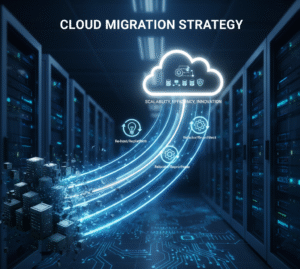
Moving your business to the cloud is a key step for growth and innovation. However, tapping into cloud benefits requires more than just shifting workloads; it demands a solid cloud migration strategy. A well-crafted strategy ensures your transition minimizes risks, controls costs, maintains security, and aligns with your business goals. This guide offers simple steps, helpful tips, and best practices to build an effective cloud migration strategy in 2025.
What is a Cloud Migration Strategy?
A cloud migration strategy is a comprehensive plan for moving your applications, data, and IT systems to a cloud environment. This plan defines what to migrate, how to execute the transition, and when to move each component. Its goal is to reduce downtime, optimize costs, secure data, and accelerate business value from the cloud.
Why You Need a Cloud Migration Strategy
- Align Migration with Business Goals: Every move should support outcomes like agility, cost reduction, or compliance.
- Avoid Downtime and Data Loss: Planning ensures smooth operations without interrupting services.
- Control Migration Costs: Clear planning helps prevent budget overruns through resource optimization.
- Ensure Security and Compliance: Safeguarding sensitive data meets regulatory requirements and builds trust.
- Improve Migration Speed and Success: Well-structured phases and procedures boost efficiency and reliability.
Popular Cloud Migration Strategies
Choosing the right approach is critical. The most common cloud migration strategies include:
- Rehost (Lift and Shift): Moving applications as they are without modification. It’s quick but may miss cloud-native benefits.
- Replatform (Lift and Optimize): Making minor adjustments to improve performance on the cloud platform.
- Refactor: Redesigning the application to leverage cloud native architectures like microservices and serverless.
- Repurchase: Replacing existing applications with cloud SaaS alternatives to reduce management overhead.
- Retain: Keeping specific systems on-premises due to complexity or compliance reasons.
- Retire: Phasing out obsolete applications to reduce costs and complexity.
Step-by-Step Guide to Building Your Cloud Migration Strategy
Step 1: Assess Your IT and Business Needs
Start with a complete inventory of your applications, data, and dependencies, combined with an understanding of business objectives such as agility, cost savings, or compliance. Engage stakeholders from IT, security, and business teams to align around priorities. Identify legacy systems or technical debt that may require special handling.
Step 2: Select the Best Migration Strategy for Each Workload
Use the ‘6 Rs’ framework Rehost, Replatform, Refactor, Repurchase, Retain, Retire—to categorize applications. Evaluate each workload’s readiness for cloud, complexity, and business value to select an approach that balances speed, cost, and benefit.
Step 3: Plan the Migration Roadmap
Develop a phased migration plan prioritizing applications by business impact and risk. Set clear timelines, define milestones, allocate responsibilities, and prepare detailed rollback procedures. Document dependencies carefully to avoid performance or integration issues post-migration.
Step 4: Prepare the Cloud Environment
Establish the cloud infrastructure by setting up secure networking, identity and access management with strict policies, data encryption, and compliance controls. Implement governance for resource management, cost tracking, and security. Use infrastructure automation tools such as Terraform to maintain consistency and speed in environment provisioning.
Step 5: Execute Migration in Phases
Start with pilot projects or move less critical workloads first to validate procedures and tools. Utilize native cloud migration tools like AWS Migration Hub or Azure Migrate to facilitate data, application, and server transfer. Employ deployment strategies like blue-green or canary releases to minimize downtime and enable quick recovery. Continuously monitor migration progress for issues.
Step 6: Optimize Post-Migration
After migration, monitor resource usage, application performance, and security metrics. Optimize costs by rightsizing instances, leveraging reserved instances, and adopting auto-scaling. Tune workloads for cloud-native efficiencies, ensure ongoing regulatory compliance, and incorporate lessons learned into updated cloud governance policies.
Helpful Tips for a Successful Migration Strategy
- Communicate Clearly Across Teams: Maintaining transparency avoids misunderstandings.
- Automate Wherever Possible: Automation reduces errors and improves repeatability.
- Test Migration Processes Thoroughly: Rigorous verification prevents surprises in production.
- Prioritize Security at Every Stage: Implement encryption, IAM, and monitoring from the start.
- Stay Flexible and Adapt Your Strategy: Cloud is dynamic; regularly revisit and revise plans.
FAQs
- What is the best strategy for cloud migration?
It depends on your application architecture and business goals. The ‘6 Rs’ framework guides the right choice. - How can downtime be minimized during migration?
Using phased migration with pilot projects and rollback plans helps minimize disruption. - What tools help with cloud migration?
Popular tools include AWS Migration Hub, Azure Migrate, Google Transfer Service, and Infrastructure as Code platforms like Terraform. - Should all apps be moved to the cloud?
Not always. Some apps might perform better on-premises or require re-architecture before migration.
Conclusion
Building a cloud migration strategy in 2025 requires clear alignment with your business goals, thorough IT assessment, and phased execution. By carefully selecting migration approaches, preparing environments, executing in phases, and optimizing after migration, your business ensures a secure, cost-effective, and scalable cloud journey. This strategic approach unlocks the full benefits of cloud computing, enhancing agility, innovation, and competitiveness in today’s fast-evolving digital world.


